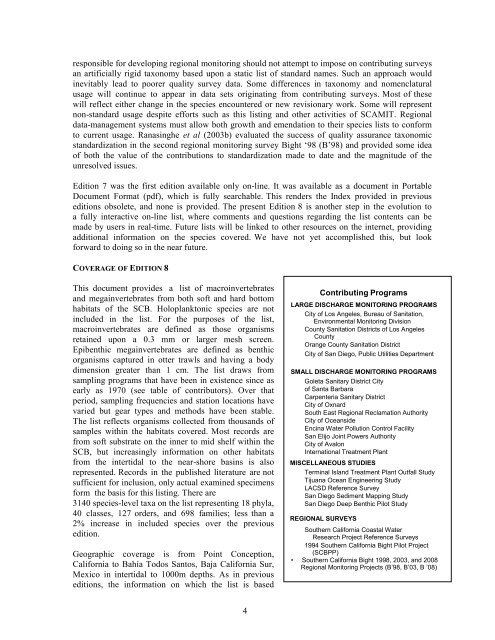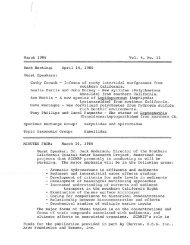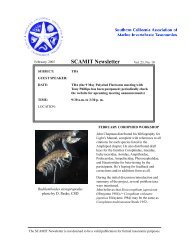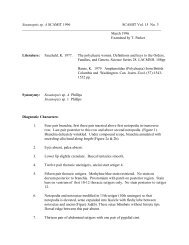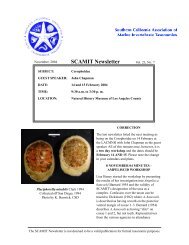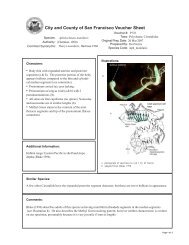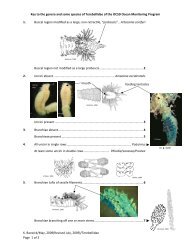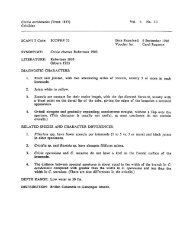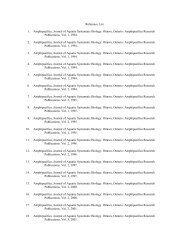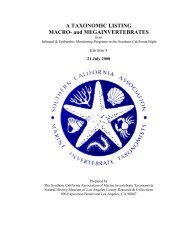A Taxonomic Listing of Benthic Macro- and Megainvertebrates - scamit
A Taxonomic Listing of Benthic Macro- and Megainvertebrates - scamit
A Taxonomic Listing of Benthic Macro- and Megainvertebrates - scamit
- No tags were found...
You also want an ePaper? Increase the reach of your titles
YUMPU automatically turns print PDFs into web optimized ePapers that Google loves.
esponsible for developing regional monitoring should not attempt to impose on contributing surveys<br />
an artificially rigid taxonomy based upon a static list <strong>of</strong> st<strong>and</strong>ard names. Such an approach would<br />
inevitably lead to poorer quality survey data. Some differences in taxonomy <strong>and</strong> nomenclatural<br />
usage will continue to appear in data sets originating from contributing surveys. Most <strong>of</strong> these<br />
will reflect either change in the species encountered or new revisionary work. Some will represent<br />
non-st<strong>and</strong>ard usage despite efforts such as this listing <strong>and</strong> other activities <strong>of</strong> SCAMIT. Regional<br />
data-management systems must allow both growth <strong>and</strong> emendation to their species lists to conform<br />
to current usage. Ranasinghe et al (2003b) evaluated the success <strong>of</strong> quality assurance taxonomic<br />
st<strong>and</strong>ardization in the second regional monitoring survey Bight ‘98 (B’98) <strong>and</strong> provided some idea<br />
<strong>of</strong> both the value <strong>of</strong> the contributions to st<strong>and</strong>ardization made to date <strong>and</strong> the magnitude <strong>of</strong> the<br />
unresolved issues.<br />
Edition 7 was the first edition available only on-line. It was available as a document in Portable<br />
Document Format (pdf), which is fully searchable. This renders the Index provided in previous<br />
editions obsolete, <strong>and</strong> none is provided. The present Edition 8 is another step in the evolution to<br />
a fully interactive on-line list, where comments <strong>and</strong> questions regarding the list contents can be<br />
made by users in real-time. Future lists will be linked to other resources on the internet, providing<br />
additional information on the species covered. We have not yet accomplished this, but look<br />
forward to doing so in the near future.<br />
COVERAGE OF EDITION 8<br />
This document provides a list <strong>of</strong> macroinvertebrates<br />
<strong>and</strong> megainvertebrates from both s<strong>of</strong>t <strong>and</strong> hard bottom<br />
habitats <strong>of</strong> the SCB. Holoplanktonic species are not<br />
included in the list. For the purposes <strong>of</strong> the list,<br />
macroinvertebrates are defined as those organisms<br />
retained upon a 0.3 mm or larger mesh screen.<br />
Epibenthic megainvertebrates are defined as benthic<br />
organisms captured in otter trawls <strong>and</strong> having a body<br />
dimension greater than 1 cm. The list draws from<br />
sampling programs that have been in existence since as<br />
early as 1970 (see table <strong>of</strong> contributors). Over that<br />
period, sampling frequencies <strong>and</strong> station locations have<br />
varied but gear types <strong>and</strong> methods have been stable.<br />
The list reflects organisms collected from thous<strong>and</strong>s <strong>of</strong><br />
samples within the habitats covered. Most records are<br />
from s<strong>of</strong>t substrate on the inner to mid shelf within the<br />
SCB, but increasingly information on other habitats<br />
from the intertidal to the near-shore basins is also<br />
represented. Records in the published literature are not<br />
sufficient for inclusion, only actual examined specimens<br />
form the basis for this listing. There are<br />
3140 species-level taxa on the list representing 18 phyla,<br />
40 classes, 127 orders, <strong>and</strong> 698 families; less than a<br />
2% increase in included species over the previous<br />
edition.<br />
Geographic coverage is from Point Conception,<br />
California to Bahía Todos Santos, Baja California Sur,<br />
Mexico in intertidal to 1000m depths. As in previous<br />
editions, the information on which the list is based<br />
Contributing Programs<br />
LARGE DISCHARGE MONITORING PROGRAMS<br />
City <strong>of</strong> Los Angeles, Bureau <strong>of</strong> Sanitation,<br />
Environmental Monitoring Division<br />
County Sanitation Districts <strong>of</strong> Los Angeles<br />
County<br />
Orange County Sanitation District<br />
City <strong>of</strong> San Diego, Public Utilities Department<br />
SMALL DISCHARGE MONITORING PROGRAMS<br />
Goleta Sanitary District City<br />
<strong>of</strong> Santa Barbara<br />
Carpenteria Sanitary District<br />
City <strong>of</strong> Oxnard<br />
South East Regional Reclamation Authority<br />
City <strong>of</strong> Oceanside<br />
Encina Water Pollution Control Facility<br />
San Elijo Joint Powers Authority<br />
City <strong>of</strong> Avalon<br />
International Treatment Plant<br />
MISCELLANEOUS STUDIES<br />
Terminal Isl<strong>and</strong> Treatment Plant Outfall Study<br />
Tijuana Ocean Engineering Study<br />
LACSD Reference Survey<br />
San Diego Sediment Mapping Study<br />
San Diego Deep <strong>Benthic</strong> Pilot Study<br />
REGIONAL SURVEYS<br />
Southern California Coastal Water<br />
Research Project Reference Surveys<br />
1994 Southern California Bight Pilot Project<br />
(SCBPP)<br />
• Southern California Bight 1998, 2003, <strong>and</strong> 2008<br />
Regional Monitoring Projects (B’98, B’03, B ’08)<br />
4


